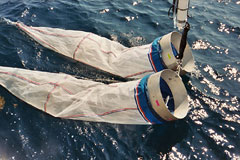

 | |||||||||||
|
|
Journals 2005/2006Julie Long
August 13, 2005 This morning Joan and I drove down to the dock where the Albatross IV is docked and immediately met up with Jerry. We took care of parking my car, obtained foul weather gear and boots for Joan and me, and took our things aboard to unpack and settle in. I am thankful that there is another teacher going through this with me. There have already been many moments in which I have felt overwhelmed. It's good to be able to share uncertainties with someone who is in the same boat as I am (pardon the pun). Everyone I have met so far- crew, scientists, NOAA officers- are so nice and more than willing to answer questions. That makes it easier. Getting the ship ready to leave has been the hardest part for me so far, mostly because there has been a lot to do but I didn't know what to do or how to do it so I felt like I was in the way. Again, Joan and I were able to commiserate because we both felt the same way.
We arrived at our first station tonight around 6:00 P.M. A station is where we take our samples of water, plankton, sediment, or all three. Technically I wasn't on duty but I wanted to work with Jerry at the first station and he and I aren't on the same watch schedule. I learned that a "watch" aboard the Albatross IV is different from a "watch" that I was used to aboard the Spirit of Massachusetts during Seamester. During Seamester, watch meant that we were awake and running the boat (navigation, watching for other boats, etc). As it turns out, watch on the Albatross IV means that you are in charge of working the stations if you come to one during your six hours. My six hours are from midnight to 6:00 A.M., and noon to 6:00 P.M. I'm on watch with Nora (a scientist from the EPA) and Joe (a scientist from NOAA). At the first station, we attached a CTD (salinity, temperature and depth recorder) to the wire of the bongo nets (fine mesh nets for collecting plankton that are shaped like bongo drums) and sent the nets over the side of the boat. Attached to the bongo nets were flowmeters to record the volume of water passing through the nets. We put paper cups on the flowmeters, which I found really interesting. Jerry explained that the cups prevent the flowmeters from spinning in the air so the reading is more accurate. The cups get washed into the bottom of the nets and we throw them out when they come back aboard. The bongo nets are lowered to within 5 meters of the bottom of the ocean floor and then brought back up. Tonight we were only in 25 meters of water so the process didn't take long. When the bongos are back up, they are hosed down so that all of the plankton collects in the bottom of the nets. The bottoms are untied and the plankton is rinsed into a sieve (fine mesh strainer). From there the plankton is preserved in jars and labeled. Two jars are collected from each station (one from each net). This first station was mostly large phytoplankton- very green.
We are going to do a total of 95 stations spread out between the NY Bight area (off Long Island), Georges Bank (off Massachusetts), and the Gulf of Maine. For the first time the EPA is aboard the NOAA cruise. There are two scientists- Don and Nora- that are doing sediment and water studies to see the health and abundance of benthic organisms and to determine the amount of toxins in the water and sediment. They are taking samples every 5th station. That will be interesting to see. |
||||||||||

